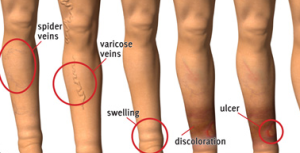-
The Progression of Clinical Vein Disease
Posted on January 24, 2017 by in e vein screening, evein screening, eveinscreening, eveinscreening.com, leg ulcer, Naples Vein Treatment, online vein screening, skin changes, spider veins, varicose vein facts, varicose veins, vein disease, venous insufficiencySpider veins are likely the first vein issue to be noticed. They occur in 40% of woman and 18% of men. Spider veins occur in the smallest surface veins. The dilation makes the veins appear to spread like spider webs.
Stage 2 “Varicose Veins”
This is the stage/classification for varicose, larger dilated superficial veins. Varicose veins are generally visible through the skin. Though occasionally pain-free, over 75% of people with this stage of disease have symptoms that cause pain and can interfere with their daily level of activity.
Stage 3 “Edema”
More advanced vein disease causes swelling of in the legs known as edema. The backflow in the veins interferes with the body’s ability to reabsorb fluid. Vein disease is the most common cause of leg swelling.
Stage 4 “Skin Changes”
Over time, venous congestion left untreated can cause changes to take place in the skin. it may become thinner and begin to discolor changing to red, brown or even white. At this stage, skin is easily damaged. It is often mistaken for other skin disorders or issues such as cellulitis, dermatitis, or even just bruising.
Stage 5 and 6 “Leg Ulcers”
This is the most advanced stage of superficial vein disease. Ulcers are caused by congestion that has advanced so much that it interferes with blood flow leaving the body unable to provide nutrients to the skin. If treatment is still not sought, ulcers may not heal properly if at all. Stage 5 is used to classify healed ulcers and stage 6 describes currently active ulcerations.
If you have possible symptoms of venous insufficiency visit www.eveinscreening.com to get started now with a FREE online vein screening.
The post The Progression of Clinical Vein Disease appeared first on Sarasota Vein Specialists | Vein Treatment For Spider Veins & Varicose Veins.







